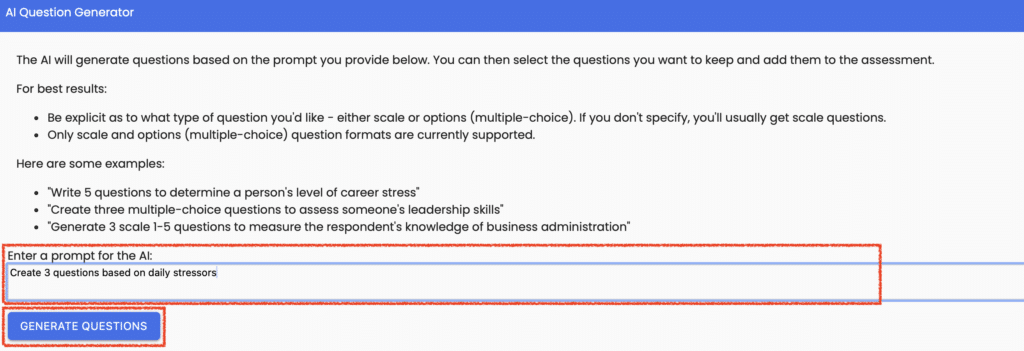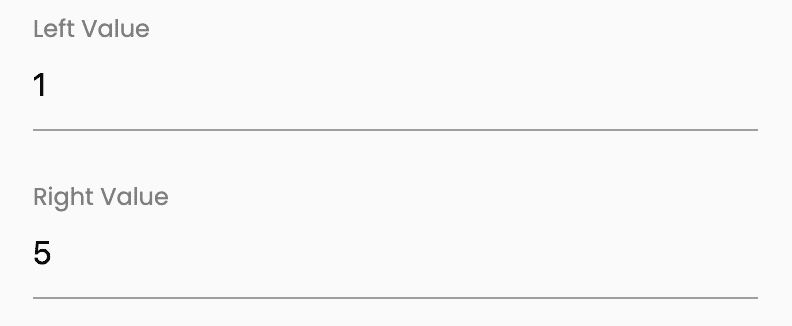- What is a Scale Question?
- Create a Scale Question
- Generate Questions With AI:
- Enter Your Question
- Set the Scale Labels
- Assign Point Values
- Choose Between Buttons or a Slider
- Set Initial Slider Value
- Score Multiplier
- Reverse Scoring Setting
- Assign Question to Type (for Type and Multi-Type Assessments)
- Assign Question to Section
- Assign a Question Identifier
- Question Required Setting
- Question Enabled Setting
- Show Question When (for Conditional Logic)
- Optional Question Notes Field
- Save Your Question
What is a Scale Question? #
A Scale Question is answered by choosing a number on a scale.
- Also sometimes called “Likert Scale” questions.
- Label either end of the scale however you like. The most common scales are 1 to 5, 1 to 7, and 1 to 10, with end labels like “Always/Never,” “Agree Strongly/Disagree Strongly,” or “A lot/None.”
- Scale questions can be scored and assigned to types (for Type and Multi-type assessments).
Create a Scale Question #
Start by entering the Agolix editor.
First, select the “Edit” link in the menu underneath your assessment.

Then click on the “Questions” tab at the top of the page.

Click on the “Add Question” button.


Alternatively, you can mouse over any existing questions and choose either the “Add Above” or “Add Below” links. These links will add your new question either above or below your existing question.
Generate Questions With AI: #
Click the “Generate With AI (Beta)” button to open the AI question functionality. Here, using AI you can create scale questions based on your search criteria.

Select “Scale Question” from the list of choices and click “OK.”

Enter Your Question #
Enter your question in the editor window and adjust the styling as desired.

You can also include an image, video, symbols, and tables with your text.
Set the Scale Labels #
Next, enter your scale labels.

The default labels are “Less” and “More,” but you can set these to whatever makes sense for your question.
Assign Point Values #
Next, set your desired point values for each end of your scale.

Choose Between Buttons or a Slider #

Buttons can be used if the scale is 10 or less.
Set Initial Slider Value #
When using a slider, you can also set the initial slider value.

Score Multiplier #
With the score multiplier field, you can increase the score’s weight for your question.

For example, if you would like to double the point values assigned to your question, you can enter a score multiplier of “2”.
This means that your respondents would receive double the points that would otherwise be assigned for this question.
Reverse Scoring Setting #
Then you can decide whether to use reverse scoring for this question.

Checking this option will score your question in the opposite direction.
In other words, reverse scoring means that selecting low on the scale for this question will result in a high point value and vice versa.
Assign Question to Type (for Type and Multi-Type Assessments) #
For Type and Multi-type Assessments only, you will see a field where you assign your question to one of the types you’ve set up under the “Types” tab.

The point values set for this question will be assigned to the type specified here.
Assign Question to Section #
In the Setup Tab, you can configure your assessment to display your questions by section. If you’ve done so, you’ll see a setting here to assign your question to one of your sections.

Please note that sections control how questions are separated visually during the assessment. Sections do NOT affect scoring.
- For Type or Multi-Type Assessment: To set up types or categories for scoring, create types on the “Types” tab. Learn more about types.
- For Simple Assessment: If you need to create multiple categories or types and provide a separate score for each, please create a Type or Multi-type assessment.
- We can help you convert your Simple assessment into a Type or Multi-type one. Please contact us for assistance.
Assign a Question Identifier #
This optional field enables you to reference the answer to a question.

This field can display a respondent’s answer in the assessment results by invoking it as a merge code.
Note: If you want to use this question as a trigger question for conditional logic, it is necessary to specify a question identifier.
You can also use the question identifier to pass the answer through a webhook or Zapier integration to an outside application.
Question Required Setting #
Scroll down to see where you can require the respondent to answer the question.

If this box is unchecked, this question is optional, and the respondent can proceed to the next question without answering it.
Question Enabled Setting #
Next is the “Question Enabled” setting. Each question that you create will be enabled by default. You can disable individual questions in your assessment by unchecking this box.

Disabled questions will not be presented in your assessment.
Show Question When (for Conditional Logic) #
With Advanced, Private Label, and Enterprise plans, the “Show Question When” field is shown:

By default, this option is off so your question will always be shown when the Question Enabled setting above is enabled.
Please see Add Conditional Logic for details on how to use this feature.
Optional Question Notes Field #
Finally, there’s an additional text window where you can add notes that will appear below the question in your assessment.

You can also present your “Question Notes” with assessment results when you enable the “Show questions and responses” setting for the “Edit On-Screen Results,” “Edit Emailed Results,” and “Edit PDF Report” settings on the “Results” tab.
Save Your Question #
When you click the “Save” button to store your question settings, you are returned to the “Questions” tab, where you can see your recently-added question.

Please review the rest of the User Guide to learn more about our software.
Thank you for choosing Agolix by Assessment Generator!




